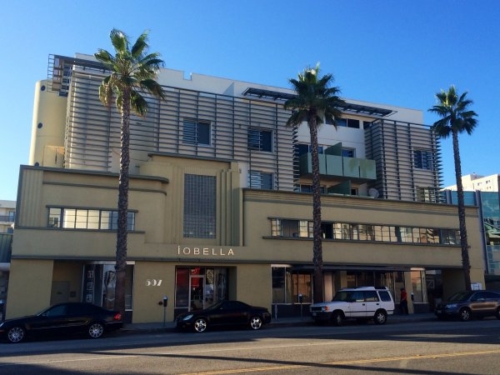Streamline Moderne Commercial Building

- Known As
- Streamline Moderne, Art Deco
- Architect
- W. Douglas Lee
- Built
- 1940
- Designated
- February 10, 2003
Constructed on the eve of World War II, this Streamline Moderne commercial building originally housed the LLO-DA-MAR bowling alley which remained in operation for over thirty years. In its original form, the 14,000-square-foot building contained a single story and featured (in addition to bowling), a coffee shop, a cocktail lounge and a mezzanine area for offices. In the early to mid-1970s the building was renovated to accommodate retail shops on the ground level. Storefronts with floor-to-ceiling glass windows were added and the interior was sectioned into smaller spaces. These changes have compromised the original architecture somewhat but the structure remains a good example of Streamline Moderne.
Streamline Moderne was unlike many of the architectural styles of the early twentieth century in that it was not a revival of historic architectural forms. Instead, it was inspired by modern industrial design—particularly that of high-speed transportation machines such as planes and automobiles. Notable features of this style visible here include the use of narrow horizontal bands of windows to create a sense of movement, the use of glass block (seen here in a central field), and aerodynamically shaped accents including curved sills and roofline.
This forward-looking style was particularly appropriate for Santa Monica when the building was constructed in 1940. The city was home to Douglas Aircraft, one of the most innovative aircraft manufacturers in the world. Though in 1940 some parts of the nation were still mired in the effects of the Great Depression, Santa Monica—thanks to Douglas—was on the rebound economically. No wonder the builders opted for the optimistic Streamline Moderne style. With the advent of World War II Santa Monica became a hub of war production, turning out tens of thousands of the most up-to-date, aerodynamically-designed airplanes and Santa Monicans in the 1940s would not have missed the connection between the city’s main industry and the architecture of the bowling alley. In short, this landmark not only captures a significant style of building, but also evokes an era of energetic change and industry that marked the city during the 1940s.
Sources:
- Santa Monica Landmarks Tour (City Planning Division, City of Santa Monica: Santa Monica, August 2003).
- Staff Report on 507-517 Wilshire Boulevard, Streamline Moderne Commercial Building, City Planning Division, City of Santa Monica.
- Arthur C. Verge, Paradise Transformed: Los Angeles during the Second World War (Dubuque IA: Kendall/Hunt Publishing Co., 1993).
- LA Conservancy. ““LLO-DA-MAR.”